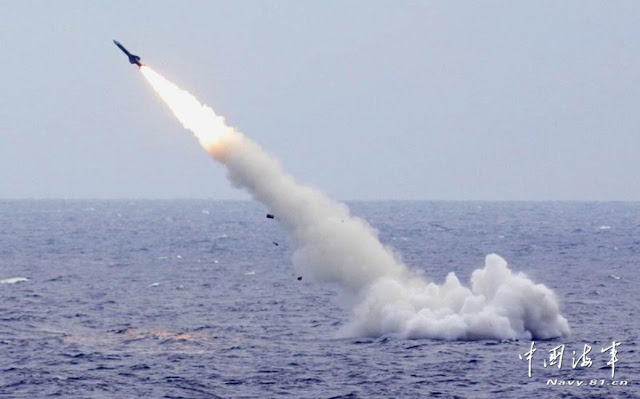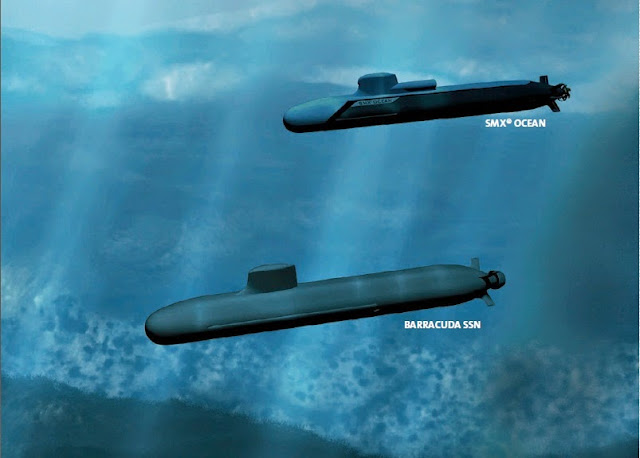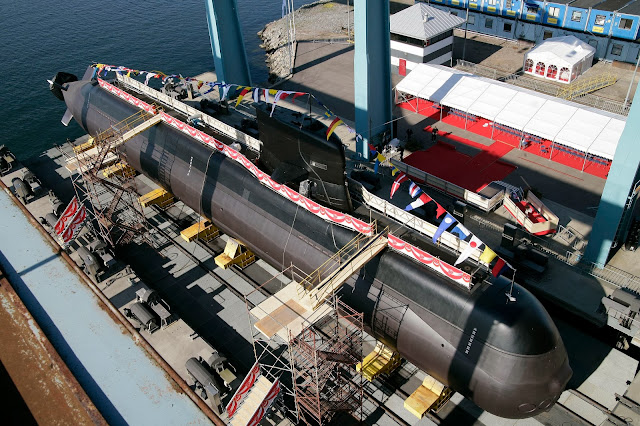Submarine Hospice?
Many of us have heard of the scandal associated with the Malaysian Scorpene-class submarine purchase, one which involved huge sums of money and resulted in the murder of the Mongolian socialite and interpreter Altantuya Shaariibuu . But there was another side story about Malaysia's quest for submarines, one that pre-dated the Scorpene deal, that not so many remembered or even knew about. This is a sad tale of the last days of two distinguished Dutch submarines, HNLMS Zwaardvis and HNLMS Tijgerhaai, brought to a location far from home and left to the elements, and eventually scrapped. It is also story about the demise of the Dutch submarine construction industry and a cautionary tale of how defence procurements should not be mismanaged.
 |
| The Zwaardvis and the Tijgerhaai underway during their heyday. Photo via Wikicommons. |
 |
| The Zwaardvis-class diesel-electric submarine of the Royal Netherlands Navy. Photo : Wikipaedia |
Dutch Submarine Construction
The Dutch were involved in submarine construction activities since 1904 when they started the construction of the submarine Onderzeese Boot 1, based on the designs from the American company Holland Torpedo Boat Co. It was to be a single boat class, eventually sold to the Dutch Navy and commissioned as the HNLMS O1. From such humble beginnings more than a century ago, the submarine building industry gradually matured and gained momentum during the years preceding World War II. The Dutch were even credited for inventing the submarine snorkel which allowed diesel submarines to run their engines to recharge their batteries while remaining submerged to reduce the risk of detection by the enemy. Unfortunately, this technology fell into German hands and saw application in the Kriegsmarine's U-Boats especially towards the final years of the war.
As the Dutch shipyards suffered extensive damage during World War Two, construction of indigenous Dutch designed submarines did not restart until the fifties with the Dolfijn-class SSK of which four boats were produced. The next generation of Dutch submarines were the Zwaardvis-class which were laid down in 1966 and commissioned in 1972. Two were built for the Dutch Navy and another two for the Taiwanese Navy in the mid-eighties. The current and final batch of submarines are the Walrus-class which had been commissioned in the early nineties and are still in active service. After that, the Dutch submarine industry collapsed as the Dutch government did not have sufficient orders for the builders and desperately needed foreign exports orders failed to materialize.
The Zwaardvis-class was to play a crucial part in the unfolding saga of the demise of the Dutch submarine construction industry.
The Zwaardvis-class SSK
The Zwaardvis-class boats are conventional diesel-electric hunter-killer submarines ( SSK ). They were based on the designs of the Barbel-class of the United States Navy with an albacore or tear-drop shaped hull. The Barbel-class was the last of the SSKs built for the USN before it developed into an all-nuclear submarine force. Two boats were built for the Dutch Navy, the Zwaardvis and the Tijgerhaai.
 |
| USS Barbel SS-580, ordered in 1955, on her last day of service 24th Oct 1988. USN Photo via Wikicommons |
In the Dutch language, Zwaardvis means swordfish and Tijgerhaai means tiger shark. Just like their namesake, the Zwaardvis-class boats are large ocean-going fleet-submarine type vessels displacing some 2408 tons surfaced and 2640 tons submerged, measuring 66.9m long and 8.4m wide. Powered by three diesel engines and an electric motor, these boats have a maximum speed of 13 knots surfaced and 20 knots submerged and an endurance of 10000nm at 9 knots. Maximum diving depth is classified but probably 200m or more. They are armed with 6 x 533mm bow torpedo tubes and carry a total of 20 torpedoes. They have a complement of 67 including 8 officers.
Built at by Rotterdamsche Droogdok Maatschappij ( RDM ) in Rotterdam, which used to be one of the largest ship builders in the Netherlands, these submarines were laid down in 1966, launched in 1970 / 1971 and commissioned in 1972. HNLMS Zwaardvis and HNLMS Tijgerhaai were to serve an uneventful career with the Dutch Navy for twenty-two years before being decommissioned in 1994 and 1995 respectively. This relatively early withdrawal from active service is probably a result of the end of the Cold War with budgetary cuts in military spending in many NATO countries. It would also mean that those hulls have some more years to go, though they might require some upgrading before being put back into service.
The Zwaardvis-class cannot be discussed without the mention that in 1982 the Taiwanese Navy, more correctly known as the Republic of China Navy ( ROCN ), placed an order for two boats which were modified variants. They were built by Wilton-Fijenoord it its Schiedam yard. These were launched in 1986 and were delivered to Taiwan in 1987. They are officially known as the Chien Lung-class ( 劍龍 級 ) meaning sword dragon ( not to be confused with the Japanese Soryu-class submarine SS-504 Kenryu which also means sword dragon ). Sometimes also referred to as the Hai Lung-class ( Sea Dragon ), these are still in active service in the ROCN today and by the looks of it, will be for a long time more to come.
After procuring the Hai Lung boats, Taiwan had actually the requirement for another eight submarines. However the Netherlands suffered from a huge diplomatic and trade fallout with China after the sale of the submarines to Taiwan and the follow-on request was denied for fear of angering China again.
 |
| SS-793 Hai Lung of the Taiwanese Navy is a modified Zwaardvis-class SSK. Photo : Wikipaedia |
Used Boats For Sale
Even before the Zwaardvis and the Tijgerhaai were decommissioned, the Dutch shipbuilding industry was already in serious trouble with over capacity and too few orders. Many went into receivership while others were broken up with profitable divisions being sold off or merged with other shipyards. RDM was no exception. Faced with bankruptcy in 1983, it was heavily restructured with the closure of its off-shore department and the repair business transferred to Wilton-Fijenoord. The remaining naval as well as the heavy tools and machinery division formed a new company RDM Nederlands BV which was government owned. For a short period in the late eighties, the construction of the four Walrus-class submarines for the Dutch Navy helped but trouble brewed again with no other follow-on orders.
By late 1991, the Dutch government divested its interest and sold RDM Nederlands to the Royal Begemann Group controlled by a businessman by the name of van der Nieuwenhuyzen who also did not manage to turn the company profitable. By 1994 the company was downsized and reorganized to RDM Technology BV and RDM Submarine BV and eventually both were taken private by van der Nieuwenhuyzen in 1996.
When the time came for the Zwaardvis boats to retire, the Dutch government tried without success to offer them to Indonesia which was once a Dutch colony but gained independence after the end of World War II. The asking price for the submarine was reportedly USD55million, a steal considering the fact that these were blue water capable designs which had a relatively short service span. By some estimates, the hulls may have another 15 years of usable life in them, perfect for a small navy that needed to start building up a submarine force from scratch. Without any buyers in sight, the submarines were decommissioned and eventually sold to RDM Submarines for an undisclosed sum in 1996.
RDM Submarines had at that time an advanced attack submarine design known as the MORAY - Multi Operational Requirement Affected Yield which was based heavily on the Walrus-class SSK, the Netherland's follow-on class after the Zwaardvis-class. It had a modular design and could be adapted for the different needs of various navies. An air-independent propulsion system could be optionally installed if the customer so wishes. The strategy for RDM Submarines was to bundle the Moray with the two used Zwaardvis boats to small navies who are keen to acquire submarine capabilities. The older boats would be used for training straight away while the new builds were under construction. By the time the advanced Morays were commissioned, the crew would have been absolutely ready for them. The Moray-class submarines were offered to the Indonesians in 1996 but they preferred the German Type 209. They were then offered to Egypt presumably through the US as part of the foreign military aid package but it did not materialize. Portugal was the next on the list that did not select the Moray. It was a good design on paper but the trouble was the Dutch government had no need for it at that time and without an existing functioning build no other navy was prepared to take the risk to order it.
In April 2000 rumours emerged about a possible deal with Malaysia for the two old boats to be used as training submarines. Jane's Defence Weekly subsequently reported that Malaysia is negotiating for a five year lease contract with RDM Submarines for the two Zwaardvis boats. By Oct 2000, the two submarines were loaded onto the heavy dock vessel Smit Explorer and were shipped to Lumut, Malaysia where they were supposed to be refurbished by PSC Naval Dockyard, RDM Submarine's selected partner, and then offered to the Royal Malaysian Navy as training vessels. All this happened before Malaysia had even made any formal agreements with RDM Submarines regarding the two boats but presumably the Dutch company must have been quite confident of clinching the deal to have shipped the submarines all the way to Malaysia. Conversely, RDM could have shipped them to Malaysia to have them refurbished there and to have them available for trials to increase its chances of leasing them or selling them to the Malaysian Navy.
The two submarines arrived at Lumut sometime in mid-December 2000 and were tied up at PSC-Naval's wharf where nothing much was done for a long time. Indeed by 2001 Malaysia had already indicated that they would be buying new submarines and the Dutch boats were not going to be part of the deal. Their presence in Lumut lead some Malaysians to believe that their country had already acquired and operated submarines. Some even swear that they sometimes see only one submarine moored at Lumut implying that one or the other boat must have been active and out at sea. In reality, the two boats never went anywhere and were not upgraded or refurbished. Malaysia never did lease or buy the Zwaardvis submarines, and by 2002 made the decision to acquire a pair of the French Scorpene submarine with an older Agosta 70B thrown in as a training boat. The first Scorpene submarine only arrived in Malaysia in early September 2009.
 |
| The Ex-HNLMS Zwaardvis and Tijgerhaai moored at Lumut Naval Base in Malaysia. Photo : RDM Submarines |
 |
| RMN's Scorpene-class SSK. Photo : LIMA |
Stranded In Lumut
For the next 3 to 4 years, the Zwaardvis submarines remained stranded in Lumut with their owners still in search of a buyer. But as time passed, the condition of the disused boats could only deteriorate, especially in the harsh tropical environment like Lumut, and the boats became less and less saleable. Without any successful submarine sale, new or used, the viability of RDM Submarines as a company also became more and more tenuous.
By 2005, a PSC-Naval Dockyard spokesperson claimed that the submarines could no longer move under their own power. The Dutch government had also became increasing worried that in-lieu of the maintenance and berthing fees owed to PSC-Naval Dockyard which could accumulate to substantial amounts over a period of 5 years, the submarines might be seized and sold off to unsavory third parties who might then have unauthorized access to sensitive equipment or technology. It demanded that RDM Submarines make arrangements to ship the submarines back to the Netherlands or else to have them scrapped.
When those demands were not met, the Dutch government even took RDM Submarines to court, but it all amounted to nothing as RDM was then in its death throes and was in no financial position to implement anything. In the end, the Dutch government had to pay for the submarines to be scrapped, which probably happened in 2006.
 |
| Google Earth Image dating back to 27th Sep 2005 showing two submarines moored at PSC-Naval Dockyard's wharf at Lumut. |
 |
| Lumut today : Submarines long gone. Boustead Naval Yard ( formally PSC Naval Dockyard ) to the west and RMN Lumut Naval Base to the east. |
 |
| Lumut Naval Base as it appears today. Photo : RMN Tweet |
A Sad Way To Die
It was a tragic and wasteful end to the two Zwaardvis submarines as when they were being retired in the mid-nineties, they could still have served useful lives as training boats or even remained operational after a mid-life upgrade. If they had remained in the Netherlands, perhaps they could also have a chance of being preserved as a museum boat, or to be used as a target for SINKEX live firing exercises, or to be sunk as artificial reefs, anything useful apart from just being sold as scrap metal.
After being left rotting at the wharves of PSC-Naval in Lumut for years, the eventual scrapping of the Zwaardvis boats also signaled the end of the submarine construction industry for the Netherlands. Such capability and the skilled work force tied to the industry would be extremely difficult if not impossible to reacquire once lost.
Had the Dutch government defied Chinese pressure and gone ahead to sell Taiwan the additional eight modified Zwaardvis submarines which the ROCN desperately needed, things might be very different today. RDM Submarines might just have stayed in the black long enough to secure other deals to allow the Dutch to maintain its strategic capability in submarine construction, maybe even long enough to participate in the Walrus-class replacement program. However, that was not the case. RDM Submarines was long gone. The Moray-class submarine whose fate was once so closely linked to the Zwaardvis boats would forever remain a paper design and to this day was never ever constructed or sold.
Now should you happen to chance upon a glowing apparition off the seas of Lumut on a dark and stormy night, emerging from the depths and taking to the skies, you'll know it's got to be either the Zwaardvis or the Tijgerhaai, still prowling the oceans as they always did, still conducting their eternal combat patrols .......
 |
| Flying Dutchman rendition of SS-581. |




























